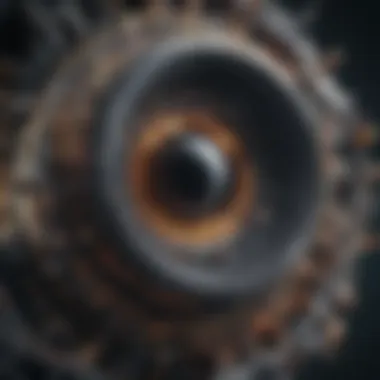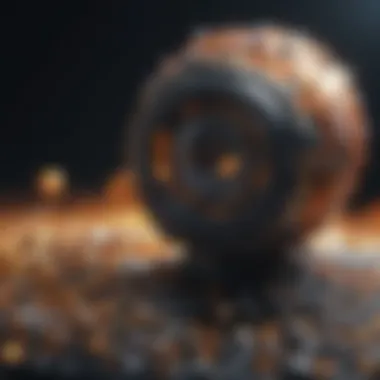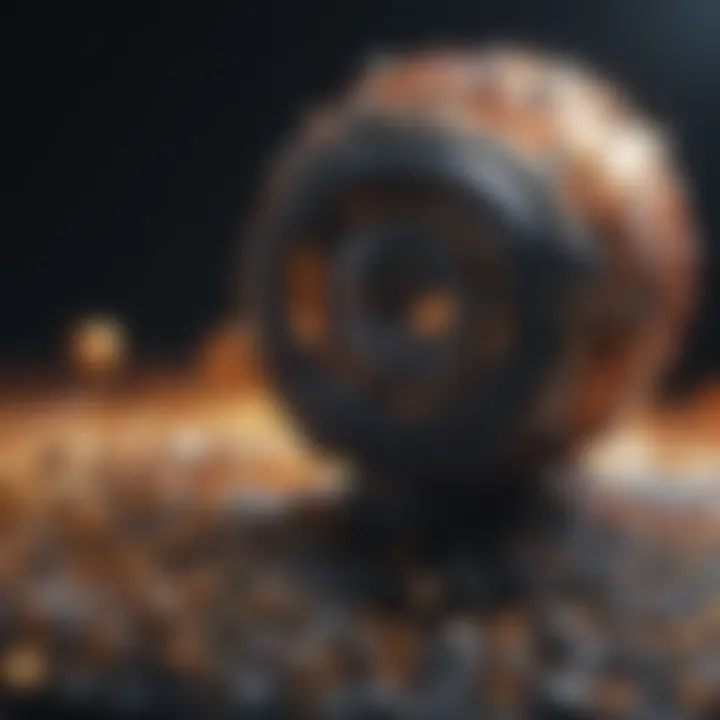Deep Learning in Microscopy: Revolutionizing Imaging Techniques


Intro
The intersection of deep learning and microscopy fosters unexplored avenues for scientific advancement. With the growing complexity of biological systems and the need for accurate imaging, traditional microscopy techniques often fall short in their capabilities. This evolving landscape creates an imperative for enhanced imaging solutions, paving the way for deep learning methodologies.
Deep learning, a subset of artificial intelligence, employs neural networks to learn from data patterns. Its implementation in microscopy provides an efficient means to tackle challenges faced by researchers. By integrating these advanced algorithms into imaging processes, it is possible to achieve higher resolution, faster image acquisition, and automated analysis.
As we delve deeper into the transformative nature of deep learning in microscopy, it is crucial to understand its foundations, applications, and implications for the future of research and clinical practices.
Prelude to Deep Learning and Microscopy
The intersection of deep learning and microscopy represents a pivotal shift in how we acquire and analyze images. This topic is essential not just for its technological advancements, but for its profound implications on research and clinical practices. Understanding deep learning provides clarity on various methodologies applied to enhance microscopy. As demands for more precise imaging grow, professionals must adapt to these developed techniques.
Deep learning, part of machine learning, uses neural networks to analyze and interpret data. It assists in automating tasks that were previously manual, significantly increasing efficiency and accuracy in microscopy. The incorporation of deep learning enhances image quality, modifies resolution, and accelerates analysis speed. Researchers and clinicians benefit from these improvements, leading to better outcomes for studies and diagnostics alike.
Furthermore, this integration also addresses existing limitations faced in traditional microscopy methods. Techniques such as noise reduction and object detection are optimized through algorithms, making tools more reliable. Hence, appreciating the fundamentals of deep learning within microscopy is key for anyone engaged in this field.
Defining Deep Learning
Deep learning refers to a subset of artificial intelligence within machine learning that employs layered neural networks. These networks consist of interconnected nodes simulating the human brain's processing approach. Unlike basic machine learning, deep learning can analyze vast amounts of data quickly and effectively, enabling complex image interpretations. The ability to learn patterns and features from images is crucial for both scientific and medical microscopy.
Overview of Microscopy Techniques
Microscopy involves various techniques ranging from light microscopy to electron microscopy. Each offers distinct advantages based on application:
- Light Microscopy: Utilizes visible light for imaging. It can be employed for live cells and provides color images, but it often lacks the resolving power necessary for detailed intracellular structures.
- Fluorescence Microscopy: This variant excites specific fluorescent dyes, allowing researchers to visualize particular cellular components. It is frequently applied in biological studies and diagnostics.
- Electron Microscopy: This technique uses electron beams, enabling extremely high resolution. It is essential for visualizing fine cellular structures at the nanometer scale, but often requires complex sample preparation.
Understanding these techniques lays a foundation for exploring how deep learning changes their functionalities.
The Convergence of Deep Learning and Microscopy
The fusion of deep learning and microscopy has introduced a new era in imaging capabilities. As imaging technology has evolved, deep learning algorithms have enhanced the automation, speed, and accuracy of image analyses. The process of identifying patterns or features in images is accelerated due to sophisticated algorithm training, which continuously learns from new datasets.
For instance, denoising networks have emerged to cleanse images of noise while preserving critical structural details. Additionally, automated segmentation allows for faster and more accurate identification of cellular components, which saves valuable time in research settings.
In summary, this convergence allows for deeper insights and discoveries in various fields, including biology and materials science. Substantial advancements made possible by these technologies push the boundaries of traditional microscopy, making complex analyses more accessible and efficient.
Fundamentals of Deep Learning in Image Processing
Deep learning has become an essential area of study due to its profound impact on image processing. Specifically in microscopy, it enhances imaging capabilities and enables more thorough analysis. By applying deep learning methods, researchers can improve image quality, analyze extensive datasets, and gain insights that were previously difficult to achieve.
The strategies learned from deep learning techniques are vital in effectively processing the large amounts of data generated in microscopy. These techniques rely on complex algorithms that can improve the resolution of images, automatic detection of structures within images, and even segmentation of different components at the cellular level.
Neural Networks and Their Architecture
Neural networks serve as the foundation of deep learning in image processing. They mimic the human brain's operations through interconnected nodes or neurons that process input data. Each neuron receives a set of inputs, applies a function, and sends the output to the next layer.
The structure of neural networks can greatly vary, but they generally consist of an input layer, hidden layers, and an output layer. The input layer takes the original image data. Hidden layers assist in feature extraction and transformation, and the output layer generates the final prediction or processed image.
Activation functions, such as ReLU (Rectified Linear Unit) and sigmoid, are crucial as they introduce non-linearities into the model, allowing it to capture complex relationships in the data. The architecture commonly used depends on the specific task, whether it is object segmentation or enhancement of image quality.
Training and Validation of Models
Training a deep learning model involves feeding it large amounts of labeled data. This is vital as the model learns to associate inputs with expected outputs based on examples. The training process includes optimizing the model parameters through backpropagation. It adjusts weights to minimize the loss function, which quantifies how far the model’s predictions are from the correct answers.
To ensure that the model generalizes well to unseen data, validation is essential. This involves splitting data into training and validation sets. The model's performance on the validation set indicates if it is overfitting or can be improved further.


Common Loss Functions and Optimization Techniques
Loss functions evaluate how well the model's predictions align with the actual outcomes. Common loss functions in image processing tasks are Mean Squared Error for regression tasks and Cross-Entropy Loss for classification tasks. Each loss function serves a specific purpose based on the problem statement.
Optimization techniques are crucial as they guide the model towards improved performance. Algorithms such as Adam or Stochastic Gradient Descent are frequently used due to their efficiency in navigating complex loss landscapes. They adjust the learning rate and help in converging to a local minimum, ensuring the model improves its accuracy over time.
Applications of Deep Learning in Microscopy
The importance of exploring the applications of deep learning in microscopy lies in the revolution it brings to imaging techniques and data analysis. As the field of microscopy continues to evolve, the integration of deep learning enables researchers to extract more meaningful insights from their data. This section discusses how deep learning enhances image quality, automates object detection, and streamlines quantitative image analysis, ultimately leading to more accurate results and broader applications in various scientific domains.
Enhancement of Image Quality
Denoising Techniques
Denoising techniques are crucial in improving the clarity of images captured through microscopy. Noise can arise from several sources, such as electrical interferences and sample imperfections. The key characteristic of deep learning-based denosing methods is their ability to learn directly from the data, thereby distinguishing between genuine signals and noise. This makes them a beneficial choice for researchers needing high-quality images for analysis.
A unique feature of denosing techniques is that they can process images in different formats, whether 2D or 3D. This versatility offers significant advantages, allowing clearer visualization of intricate structures. However, there can be a downside; depending on the complexity of the model, processing times may increase, impacting the efficiency of image acquisition during experiments.
Super Resolution Methods
Super resolution methods focus on enhancing the spatial resolution of images, allowing researchers to observe finer details that traditional microscopy would miss. They employ algorithms that synthesize high-resolution images from several lower-resolution captures. The ability to produce images with increased detail is a primary reason for the popularity of these methods in microscopy.
One notable feature is that these methods can regenerate specific details based on learned patterns from the training dataset, leading to rapid advancements in imaging research. While the advantages are evident—such as revealing more about cellular structures—the challenges include the need for large datasets to train the models effectively and potential artifacts that may arise in the generated images.
Automated Object Detection and Segmentation
Automated object detection and segmentation represent a significant advancement in image analysis. Through deep learning, systems can automatically identify and separate objects within images, such as cells or particles. This automation significantly reduces the manual workload of researchers, leading to faster results and minimizing human error. Moreover, employing deep learning for this task improves accuracy compared to traditional methods.
Integration of these technologies allows researchers to analyze vast datasets without the need for continuous human intervention, fostering a more efficient workflow. The strong performance in diverse imaging scenarios emphasizes the potential of automated detection and segmentation in diversified research fields.
Quantitative Image Analysis
Quantitative image analysis benefits immensely from deep learning techniques. These methods enable the extraction of precise measurements and characteristics from images, transforming qualitative observations into quantitative data. Researchers can evaluate metrics such as size, shape, and intensity with much higher accuracy than conventional approaches.
Furthermore, deep learning methods can handle complex variations in images, including those due to differences in staining or variability in sample preparation. This capability is essential for studies involving large sample sizes or screening. Nevertheless, the requirement for annotated datasets in the training phase may present a challenge, as generating such datasets can be resource-intensive.
In summary, the applications of deep learning in microscopy significantly enhance imaging processes. They provide several benefits, including improved image quality, automation, and robust quantitative analyses. These advancements pave the way for transformative changes across research disciplines, addressing the increasingly complex challenges in microscopy.
Impact on Various Microscopy Modalities
The impact of deep learning on different microscopy modalities cannot be overstated. Each type of microscopy has its unique characteristics and challenges. Deep learning has emerged as a transformative force in enhancing the capabilities of these modalities, pushing the boundaries of what is possible in imaging and analysis.
Fluorescence Microscopy
Fluorescence microscopy is widely used in biological research. The technique relies on the emission of light from fluorescently labeled specimens. Deep learning greatly enhances image quality by improving signal-to-noise ratios. One of the key features is noise reduction, which allows researchers to visualize structures that might otherwise be obscured. Moreover, deep learning algorithms enable more accurate localization of fluorescent signals, thus improving quantitative analysis.
Key benefits of applying deep learning in fluorescence microscopy include:
- Enhanced resolution of images.
- Improved detection of weak fluorescence signals.
- Faster processing times, allowing for high-throughput studies.
These advancements are particularly valuable in live cell imaging where dynamic processes are studied.
Electron Microscopy
Electron microscopy offers high resolution and detail of specimens at nanometer scales. However, one of its challenges is data management due to the large file sizes generated. Deep learning streamlines data handling and image reconstruction methods.


With advancements in neural architectures, segmentation of complex structures becomes more efficient. For example, machine learning models can differentiate between various cellular components accurately. Automated analysis also leads to faster turnaround times in research, making it a desirable method for many labs.
The importance of deep learning in electron microscopy includes:
- Increased automation in image analysis.
- Reduction in time and effort spent on manual interpretations.
- Enhanced ability to analyze large datasets effectively.
Live Cell Imaging
Live cell imaging is crucial in studying cellular processes in real time. Deep learning allows for higher frame rates with reduced motion artifacts. Algorithms are now capable of tracking cells over time, providing insights into their behavior and interactions.
Moreover, when combined with fluorescence methods, deep learning techniques can enhance the clarity and specificity of live imaging. This synergy can result in better insights into complex cellular mechanisms.
Significant advantages include:
- Precise tracking of moving targets in live cells.
- Minimization of phototoxic effects in samples.
- Real-time analysis capabilities, which can dramatically enhance experimental workflows.
Multimodal Imaging Techniques
Multimodal imaging refers to the combination of different microscopy techniques to capture comprehensive data about samples. By integrating deep learning, the analysis of multimodal data becomes more cohesive. This integration offers a broader view of specimens, assimilating data from fluorescence, electron, and even MRI imaging.
The synergistic effect of multimodal imaging combined with deep learning leads to:
- Improved data redundancy reduction.
- Enhanced correlation of different imaging modalities.
- More profound insights into complex biological systems.
In summary, deep learning stands as a critical pillar in the evolution of microscopy methodologies. Each modality benefits uniquely from these advancements, shaping research directions and opening new avenues for discovery. It is clear that as these technologies continue to evolve, their impact across various microscopy techniques will only deepen.
Challenges and Limitations
The incorporation of deep learning in microscopy carries substantial promise, yet it does not arrive without its own set of challenges and limitations. These obstacles, if not addressed, can hinder the optimization and utility of deep learning solutions within the microscopy landscape. Understanding these significant barriers aids researchers and practitioners in navigating the complexities inherent in the integration of advanced technologies.
Data Acquisition and Management
The very foundation of effective deep learning is robust data acquisition. The microscopy domain generates copious amounts of high-resolution data. However, collecting this data can be fraught with issues. Inconsistencies in sample preparation, imaging conditions, and instrumentation can lead to variability, making it difficult to train models effectively.
Moreover, data management becomes daunting as datasets grow. Researchers must implement systems to store, organize, and retrieve large sets of imaging data efficiently. Not only does this hinge on physical storage solutions, but also on software tools that can facilitate data access while ensuring compliance with privacy standards.
Model Interpretability
While deep learning offers powerful predictive capabilities, interpretability of its models remains a significant challenge. Many standard deep learning models operate as black boxes, rendering it difficult to understand how inputs are transformed into outputs. This lack of transparency raises concerns, especially in clinical settings where understanding the rationale behind a decision can be paramount.
Researchers thus face the challenge of developing interpretable models that provide not only accurate predictions but also insights into decision-making processes. This is essential not only for trust in the results but also for the continued acceptance of deep learning tools in microscopy.
Computational Resource Requirements
The effectiveness of deep learning in microscopy is heavily dependent on the computational resources available. Training sophisticated models can be resource-intensive, requiring high-performance hardware. This can act as a restrictive barrier, particularly for smaller labs or institutions that may lack access to such resources.
The need for powerful GPUs and extensive RAM can lead to increased operational costs. Moreover, once models are trained, ensuring their deployment and usage in regular workflows necessitates additional computational capabilities, further compounding the financial and logistical realities faced by researchers.
In summary, while deep learning is indeed transforming the microscopy field, addressing the challenges related to data acquisition, model interpretability, and computational demands is crucial for unlocking its full potential.
Future Prospects of Deep Learning in Microscopy
The future of deep learning in microscopy holds great potential for advancing research across various fields, including biology, medicine, and materials science. This section elucidates the importance of exploring the upcoming prospects of deep learning, highlighting how it can enhance imaging capabilities and drive new innovations in analysis.
Emerging Trends in Deep Learning Technology


As deep learning technology evolves, several trends are gaining traction within the microscopy domain. These trends include the development of more sophisticated algorithms that can process vast datasets quickly and accurately. For example, convolutional neural networks (CNNs) are becoming increasingly popular due to their ability to extract features from images autonomously. This development reduces the need for manual intervention and augments the efficiency of existing microscopy workflows.
Other notable trends encompass the rise of transfer learning, which allows models trained on one dataset to be adapted for different but related tasks. This capability can significantly reduce the data and time required for model training, making deep learning more accessible to researchers not specialized in computational techniques.
Additionally, the integration of edge computing with deep learning may transform how real-time analysis is approached in microscopy. By processing data closer to the source, researchers might see productivity enhancements and reduced latency in data analysis processes.
Potential for Real-Time Analysis
The capability for real-time analysis is perhaps one of the most exciting prospects in this field. Traditional microscopy techniques often require time-consuming post-processing to extract relevant information from images. However, advancements in deep learning are enabling the analysis of data as it is collected. This shift can lead to more timely interventions in clinical settings or faster insights in research laboratories.
For instance, in live-cell imaging, the ability to analyze data in real-time can provide immediate feedback on cell dynamics or reactions to treatments. Researchers can monitor processes as they unfold, leading to more informed decision-making and timely experimental adjustments. More importantly, this real-time capability could improve reproducibility in experimental results since observations can be recorded while conditions remain stable.
Integration with Croissance Digital Tools
Croissance digital tools are increasingly being viewed as vital for future microscopy applications. The integration of deep learning with platforms that offer data management and workflow enhancements can provide researchers with a comprehensive toolbox for analysis.
These tools can facilitate better collaboration between researchers by allowing them to share data and insights seamlessly. Furthermore, combining deep learning techniques with these platforms will enhance automation, enabling users to focus on interpreting results rather than managing tedious manual tasks. For example, digital tools could prioritize image datasets for analysis based on defined parameters, significantly streamlining researchers' workflow.
The synergy generated from integrating deep learning with Croissance digital tools and other software platforms equates to a transformative process in microscopy. This marriage of technology equips researchers with better resources to conduct their studies, leading to new discoveries and innovations.
Ethical Considerations and Data Privacy
As the integration of deep learning techniques into microscopy evolves, so does the necessity to confront ethical considerations and data privacy. With the potential to enhance imaging and analysis, there are invaluable benefits accompanied by critical challenges. Understanding the implications of these advances ensures responsible use and alignment with ethical standards.
Intellectual Property Issues
Intellectual property (IP) in the realm of deep learning and microscopy is a significant subject. The development of algorithms and models often involves proprietary data sets and unique methodologies. Researchers must navigate the balance of sharing knowledge and protecting their innovations. The challenge lies in defining ownership clearly. Who owns the output generated by an algorithm trained on data from different sources? Researchers and institutions must establish clear IP agreements to mitigate disputes. This becomes even more complex when collaborations involve multiple organizations or countries with differing IP laws.
To address this:
- Licensing agreements are essential to clarify who holds rights to the technology developed.
- Data sharing protocols should be enforced to ensure that all parties acknowledge contributions.
- Patents for unique algorithms can protect innovations while also fostering a culture of transparency.
A culture of collaboration, marked by clear contracts, will help prevent misunderstandings and promote innovation.
Research Reproducibility
Research reproducibility remains a cornerstone of scientific progress. In microscopy enhanced by deep learning, ensuring reproducibility can be quite challenging. The variable nature of data sets and models can lead to different outcomes, even when the same algorithm is applied. Factors such as preprocessing steps, model parameters, and hardware variations can influence results significantly.
To improve reproducibility, researchers are encouraged to:
- Document methodologies thoroughly, so others can replicate the process effectively.
- Share code alongside published studies to allow others to verify and build upon findings.
- Use standardized data sets when possible, providing a common ground for comparison.
Guaranteeing reproducibility not only increases the trustworthiness of research but also accelerates the overall advancement within the field. As deep learning continues to transform microscopy techniques, addressing intellectual property and reproducibility will be integral for sustainable innovation.
Ending
The conclusion of this article signifies a critical reflection on the transformative effect of deep learning in microscopy. As the study of biological, chemical, and physical properties becomes more complex, the integration of deep learning techniques shows that it is not just a technological advancement but a paradigm shift in imaging and analysis. This shift opens numerous possibilities and offers substantial benefits, enhancing how researchers approach microscopy techniques.
Summary of Key Findings
To summarize, the main findings of this article highlight several key aspects of deep learning's impact on microscopy:
- Enhanced Image Quality: Deep learning algorithms improve image resolution and clarity, resulting in more accurate visualizations of microscopic samples.
- Automated Analysis: These techniques enable the detection, segmentation, and quantitative analysis of objects within images, saving considerable time and effort.
- Adaptation Across Modalities: The applicability of deep learning extends across various microscopy methods, including fluorescence microscopy and electron microscopy, showcasing its versatility.
- Continued Innovation: The ongoing development in deep learning technology promises to push the boundaries of what is possible in microscopy, driving research forward in significant ways.
Deep learning is not merely a tool; it is facilitating a deeper understanding of complex systems in real time.
The Role of Deep Learning in Future Research
Looking ahead, the role of deep learning in future microscopy research cannot be overstated. As imaging requirements grow more demanding, embracing these advanced techniques will be essential for scientists. Key considerations for future research include:
- Real-Time Analysis: The potential for real-time data processing could revolutionize live cell imaging and other dynamic studies.
- Integration with Digital Tools: Future research can benefit from syncing deep learning models with existing digital analysis tools, enhancing user experience and data handling.
- Collaborative Research Efforts: It is likely that interdisciplinary approaches will yield new insights, blending software engineering, machine learning, and biology.







